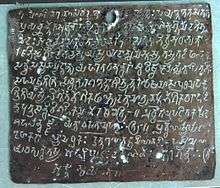Uchchhakalpa dynasty
| Uchchhakalpa | |||||
| उच्छकल्प | |||||
| Vassal of Gupta Empire | |||||
| |||||
| Capital | Uchchhakalpa (modern Unchehara) | ||||
| Government | Monarchy | ||||
| History | |||||
| • | Established | c. 5th century CE | |||
| • | Disestablished | c. 6th century CE | |||
| Warning: Value not specified for "common_name" | |||||

The Uchchhakalpa (IAST: Ucchakalpa) dynasty ruled parts of central India during 5th and 6th centuries. Their territory included north-eastern parts of present-day Madhya Pradesh. Their capital was located at Ucchakalpa, the present-day Unchehara.
The Uchchhakalpas were neighbours of the Parivrajakas, and appear to have been feudatories of the Gupta Empire. The dynasty is known from inscriptions issued by two of its kings: Jayanatha and Sharvanatha.
History

Inscriptions of two Uchchhakalpa kings, dated in an unspecified calendar era, are available: Jayanatha (Year 174–182) and Sarvanatha (Year 191–214). The era is now generally identified with the Gupta era (which begins in 318–319 CE), although some earlier scholars identified it as the Kalachuri era (which begins in 248–249 CE). The Uchchhakalpa inscriptions are written in the central Indian variety of the Gupta script. Moreover, the Bhumara stone pillar inscription names the Uchchhakalpa ruler Sharvanatha and the Parivrajaka ruler Hastin as contemporaries. This suggests that both were vassals of the Guptas, and the calendar era mentioned in the Uchchhakalpa inscriptions is the Gupta era.[1]
According to these inscriptions, the earliest king of the dynasty was Oghadeva. He was succeeded by Kumaradeva, Jayasvamin, and Vyaghra. Jayanatha, the dynasty's earliest king attested by his own inscriptions, was a son of king Vyaghra and queen Ajjhitadevi. Jayanatha was succeeded by Sharvanatha, who was his son from queen Murundasvamini.[2] Nothing is known about the successors of Sharvanatha.[3]
Genealogy
The following kings and queens of the dynasty are known (IAST names):[2]
- Mahārāja Ogha-deva and Mahādevi Kumarā-devī
- Mahārāja Kumarā-deva and Mahādevi Jaya-svāminī
- Mahārāja Jaya-svāmin and Mahādevi Ramā-devī
- Mahārāja Vyāghra and Mahādevi Ajjhita-devī
- Mahārāja Jaya-nātha and Mahādevi Murunda-svaminī, r. c. 493–507 CE
- Mahārāja Śarva-nātha (Sharvanatha), r. c. 508–533 CE
Inscriptions
The following inscriptions from the Uchchhakalpa reign have been discovered.
| Find spot | Issued by | Year (CE year, assuming Gupta era) | Purpose | Source |
|---|---|---|---|---|
| Karitalai | Jayanatha | 174 (493–494 CE) | Land grant | [4] |
| Khoh | Jayanatha | 177 (496–497 CE) | Grant of a village to Brahmins | [3] |
| Unchehara | Jayanatha | 182 (501–502 CE) | Village grant. See Katni copper-plate of Jayanātha. | [5] |
| Sohawal | Sharvanatha | 191 (510–511 CE) | [1] | |
| Khoh | Sharvanatha | 193 (512–513 CE) | Village grant | [3] |
| Khoh | Sharvanatha | 197 (516–517 CE) | One of the copper plates is missing, but it appears to be a village grant as it quotes a Mahabharata verse which states that it is the king's duty to protect the land granted by him or his ancestors. | [3] |
| Navagrama | Sharvanatha and Parivrajaka ruler Hastin | 198 (517 CE) | Grant of a village to the Brahmins of Parashara gotra and Madhyandina Shakha | [6] |
| Khoh | Sharvanatha | 214 (533–534 CE) | Grant of villages for the worship of the goddess Pishtapurika | [3] |
| Khoh | Sharvanatha | Undated | Grant of a village to Chhodugomika | [3] |
References
- 1 2 Ashvini Agrawal 1989, p. 261.
- 1 2 Manabendu Banerjee 1989, p. 242.
- 1 2 3 4 5 6 Om Prakash Misra 2003, p. 8.
- ↑ Madan Mohan Upadhyay 2005, p. 27.
- ↑ Madan Mohan Upadhyay 2005, p. 28.
- ↑ Moirangthem Pramod 2013, p. 92.
Bibliography
- Ashvini Agrawal (1989). Rise and Fall of the Imperial Guptas. Motilal Banarsidass. ISBN 978-81-208-0592-7.
- Moirangthem Pramod (2013). "The Parivrajaka Maharaja" (PDF). Asian Journal of Multidimensional Research. 2 (4). ISSN 2278-4853.
- Madan Mohan Upadhyay (2005). Inscriptions of Mahakoshal: Resource for the History of Central India. B.R. ISBN 9788176464963.
- Manabendu Banerjee (1989). Historical and social interpretations of the Gupta inscriptions. Sanskrit Pustak Bhandar. OCLC 22347582.
- Om Prakash Misra (2003). Archaeological Excavations in Central India: Madhya Pradesh and Chhattisgarh. Mittal Publications. ISBN 978-81-7099-874-7.
External links
- Uchchhakalpa inscriptions by D.N Lielukhine, Oriental Institute
- Siddham – the South Asia Inscriptions Database: Jayanātha and Śarvanātha